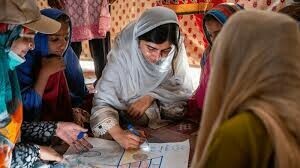ECONOMIC rejuvenation at the cost of human development can never be sustainable. Evidence shows that nations can never experience sustainable progress unless there is human capital accumulation, ie, improvement in the quality of population. Undisputedly, health has a major role to play in human development.
In Pakistan, health remains one of the most neglected areas in policy matters. For FY-23, the budget for healthcare is a mere 2.1 per cent of GDP. This lack of attention from the government towards healthcare has led to a deterioration in the quality and quantity of the facilities provided. Annual per capita spending on healthcare in Pakistan is a mere $40, one of the lowest in the world. Out of this, the government spends only one-third; the remaining is covered out of pocket. The infant mortality rate stands at 56.9 deaths per 1,000 live births, and the maternal mortality rate at 186 per 100,000 births. Only 0.6 hospital beds are available per 1,000 persons. Basic Health Units and Rural Health Centres remain largely inaccessible, understaffed and/or deserted.
Given that human capital is the foundation of sustainable economic growth, the recent budget cuts in social spending will worsen the condition of the healthcare infrastructure. With the skyrocketing cost of living, rising poverty and the Sehat Card’s uncertain fate, it is important to talk about healthcare in Pakistan.
Owing to the limited capacity and deplorable conditions of government hospitals, the majority of the population avoids going there; preferring, instead, to visit local pirs and aamils to seek relief from their ailments. Many even resort to applying desitotkas (home remedies) shared on WhatsApp groups, which often end up worsening the condition of the patient.
UHC remains a neglected area.
The only other alternative available for poorer segments is to seek healthcare from ‘affordable’ private doctors. Contrary to expectations, this also poses a high risk. Going by the Labour Force Survey 2020-21, we can see that 37.2pc of medical practitioners in Pakistan do not hold a degree in medicine; 25pc of these do not hold a degree in any discipline. Of traditional and complementary medicine professionals, 69pc are practising without any degree.
Most of these ‘medical specialists’ end up prescribing short-term fixes to manage the symptoms, rather than accurately diagnosing the disease. Antibiotics are prescribed without reason, leading to increased antibiotic resistance. Vaccine hesitancy, lack of focus on preventive measures, increasing population and resurgence of Covid-19 have increased the demand for healthcare in Pakistan, but the rising cost of living has crippled the capacity of the poorer segments to afford it.
Achieving universal health coverage by 2030 is a key UN goal set in the Sustainable Development Goals. The government’s lack of focus on the health sector means we are lagging behind other countries. The main issue is the lack of funding, and the big question remains: with a meagre tax base of only two million taxpayers, how can the government finance UHC?
This can be done by creating opportunities for public-private partnerships between the government and health insurance providers. Mandatory health insurance for all can be a great leap towards achieving UHC. A ‘health tax’ can be imposed under which unhealthy items such as tobacco can be taxed, and the revenue collected can be diverted towards healthcare. Digital health platforms should be made ubiquitous, allowing women and children to access good quality and affordable healthcare from the
comfort of their homes. Some external borrowing can also be directed towards the health sector. In this regard, the $300m allocated to the development of National Health Support Programme by the World Bank is a step in the right direction. There is also a need for greater moderation in the healthcare sector. Stringent conditions must be met by all applicants before licences to practise medicine are issued.
However, it is not just a money problem. As a nation, there is a need for a cultural change where there is greater focus on preventive steps. This will help improve efficiency in the healthcare sector by reallocating resources to their most productive use. In Pakistan, 20m infants remain unvaccinated; 200m women lack access to family planning services. Although such preventive measures — vaccines and family planning services — have very insignificant costs, the government has failed to ensure adherence due to demand-side constraints.
Recent policy measures, such as the Sehat Card, cover the healthcare expenses of patients admitted in hospitals. By and large, the greatest fraction of healthcare expenses is accounted for by visits to OPDs and the purchase of medicines, both of which remain uncovered under the programme.
The writer is a lecturer of economics and research fellow at IBA, Karachi.
Published in Dawn, April 8th, 2023











































Dear visitor, the comments section is undergoing an overhaul and will return soon.